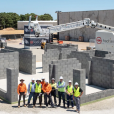The race to enable faster, smarter, and lower-power edge AI systems is intensifying – and dorsaVi (ASX:DVL) is stepping up with validation data that positions its next-gen RRAM (Resistive Random-Access Memory) technology as a serious contender in the embedded systems space.
With the global surge in demand for AI-capable wearable devices, robotics, and autonomous edge computing, dorsaVi’s announcement signals a strategic move toward high-performance sensor platforms that can make real-time decisions on-device, without draining power or sending data back to the cloud.
Performance Metrics Validate Early Promise
Following its initial assessment of the licensed RRAM platform, dorsaVi has now released validation data confirming the technology’s standout performance across several key metrics.
The company reports switching speeds of 50–200ns (nanoseconds) and ultra-low energy consumption, making it a strong fit for time-sensitive, power-restricted applications like wearables and edge AI.
dorsaVi says these results confirm the RRAM’s suitability for embedded environments, particularly where responsiveness and battery life are paramount.
Gernot Abl, Chairman of dorsaVi, said: “The integration of RRAM into edge AI platforms is a pivotal step in our evolution toward intelligent, low-power motion systems.”
Dual-Mode RRAM Enables Smart Processing at the Edge
Unlike conventional memory, dorsaVi’s platform supports both binary and analogue modes, allowing it to function as storage and as a neuromorphic processor. This means the same chip can handle both data retention and adaptive learning.
In binary mode, the technology boasts sub-100ns switching, more than 10 million write cycles, and multi-year data retention, all while running at just 2–2.5V. Analogue mode, meanwhile, allows for multi-bit storage and on-device inference, enabling smarter responses without external processing.
This dual capability is central to emerging applications in robotics, adaptive sensing, and real-time biomechanics – areas dorsaVi is actively targeting through ongoing development.
Gernot Abl added: “This technology not only enhances the performance of our existing solutions but also opens the door to future applications in AI, robotics, and neuromorphic computing.”
Head-to-Head Testing Underscores Competitive Edge
In benchmarking RRAM against peers at the 40nm (nanometre) node, dorsaVi’s platform demonstrated highly competitive performance in terms of speed, endurance, and retention.
These tests, conducted under standardised conditions aligned to real-world embedded system requirements, support dorsaVi’s claim that the platform is not just technically viable, but commercially ready.
By focusing on metrics most relevant to low-latency, real-time edge computing, the company is aligning its technology to the needs of end-use environments, not just lab results.
Strategic Roadmap: From Sensors to Smart Systems
The RRAM platform is expected to form a core component of future dorsaVi solutions, particularly its ViMove+ and workplace safety products. Integration is projected to deliver faster response times, better signal clarity, and more autonomous decision-making directly on the device.
Ongoing testing will focus on long-term stability, software integration, and miniaturisation – with further updates anticipated as commercial deployment approaches.
The company has also flagged potential strategic partnerships and adjacent market expansion, hinting at ambitions beyond the wearable space.
Looking Ahead
RRAM’s manufacturability, compatibility with CMOS processes, and simplified materials stack make it a cost-effective option for scale. dorsaVi’s internal roadmap now turns toward refining the technology stack and exploring applications where power efficiency, real-time adaptability, and on-device intelligence intersect.
While no product upgrades or commercial deals have been announced yet, the performance metrics suggest dorsaVi is on track to become a serious player in the edge AI space, backed by a strong foundation in wearable sensor tech and real-time motion analysis.
As edge computing becomes more intelligent and decentralised, dorsaVi’s RRAM technology could be the key to unlocking responsive, efficient, and adaptive systems across industries.
- NoviqTech Launches Quantum Intelligence Products, Opening Path to Enterprise-Grade Quantum AI - September 19, 2025
- BRE Wins Final Permit to Advance Rare Earth Pilot Plant in Brazil - September 4, 2025
- QIC Fund Backs Ark Mines with $4.5m to Accelerate Sandy Mitchell Development - August 26, 2025












Leave a Comment
You must be logged in to post a comment.